
The Business of Fashion
Agenda-setting intelligence, analysis and advice for the global fashion community.

Agenda-setting intelligence, analysis and advice for the global fashion community.
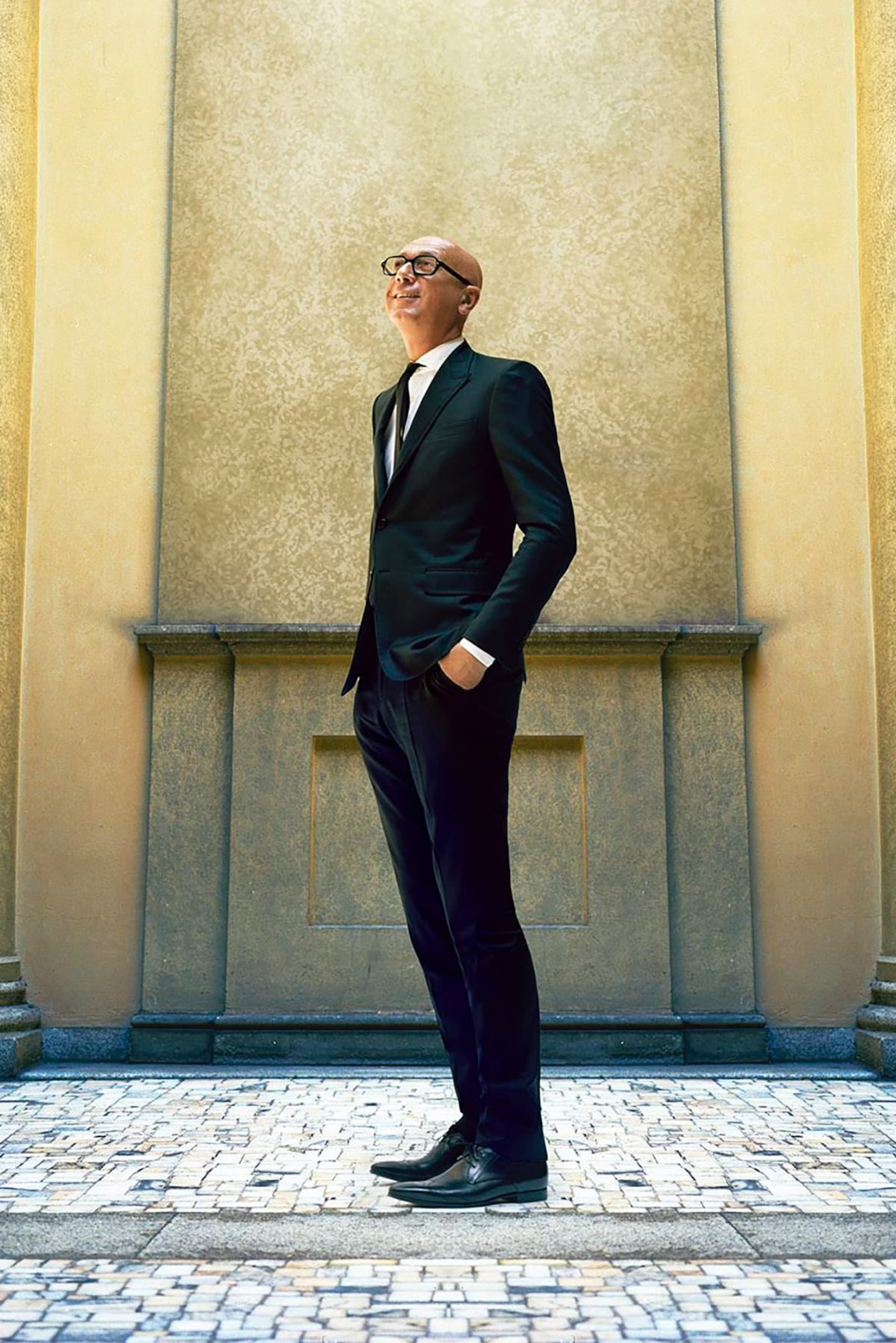
MILAN, Italy — In December 2014, Marco Bizzarri was settling into a new role as head of the Luxury Couture & Leather Goods division of Kering, overseeing a group of prestigious brands including Bottega Veneta, Yves Saint Laurent, Alexander McQueen, Stella McCartney, and Brioni.
A rising star in the luxury group’s executive ranks, the 53-year-old had already proved his mettle in driving business growth — particularly at Bottega Veneta, where annual revenues soared from €400 million to more than €1 billion under his watch. Prior to that he worked closely with Stella McCartney, whose business he brought to profitability. His new role was seen as recognition of these successes, and an opportunity to guide the development of several of Kering ’s brands, as opposed to operating one business directly.
So it came as a surprise to Bizzarri when Kering chairman and chief executive Francois-Henri Pinault asked him to take on the role as president and CEO of Gucci, following the fiery exit of Patrizio Di Marco who left suddenly at the end of last year, followed closely by his partner, and Gucci creative director, Frida Giannini.
It was the second time in a decade that Gucci found itself in the rare situation of losing both a CEO and creative director simultaneously. In 2004, Tom Ford and his trusted business partner Domenico De Sole made their own high-profile exit, after bringing the provincial Italian leather goods business back from the brink of bankruptcy and transforming it into the most desirable fashion brand in the world.
ADVERTISEMENT
Under Frida Giannini, who eventually took on the mantle of creative director in 2006, Gucci became known for its strong product focus. But Giannini largely stuck to Tom Ford’s creative template of sultry, in-your-face sexuality. Slowly but surely, even as sales continued to rise, the brand began to lose its cred, especially amongst fashion insiders. Eventually, creative stagnation began to impact revenues. Quarterly sales growth began to slow in the second half of 2013 and, by December 2014, after years of profitable growth, Gucci had experienced three consecutive quarters of declining sales.
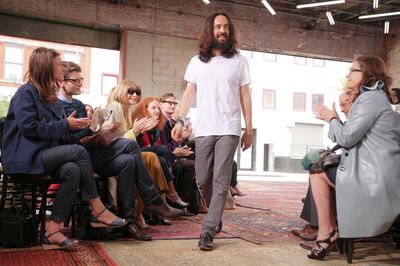
Alessandro Michele | Photo: Courtesy of BFA/Matteo Prandoni
It was time for change. Bizzarri's first step was to appoint a new creative director. He chose Alessandro Michele, a designer heretofore unknown to the fashion world, but who had worked behind the scenes at Gucci for 12 years.
Michele brought a radical new vision to Gucci, which kicked off with a hastily prepared menswear show in January that saw many hard-to-please buyers, press and insiders singing his praises, but also raised questions about how the designer’s gender-bending, romantic aesthetic could be translated into saleable product. Some longtime Gucci fans were confused by the changes, voicing their discontent on social media and calling for the return of Giannini.
But the reinvention of Gucci was underway. With each careful step since the first show, Bizzarri and Michele have engineered a complete rethinking of the company’s collections, branding, advertising, store concept and, even, corporate culture.
Early signs of progress have certainly gained the confidence of Francois-Henri Pinault: “Marco and Alessandro have already demonstrated their deep understanding of the brand’s identity and I am convinced that they have the skills needed to intensify its aura and restart its growth engine. Gucci has a history of reinvention and the new direction pointed out by its leadership team is very promising.”
But a couple of questions remain: what was the thinking behind the speed of the dramatic changes and how will this translate into financial impact for the jewel in Kering’s luxury portfolio and one of fashion’s largest and most storied businesses?
Imran Amed: You were already happy in a new role at Kering and then Mr Pinault presented you with the challenge of revitalising Gucci quite suddenly. What was it about this particular opportunity that appealed to you?
ADVERTISEMENT
Marco Bizzarri: Frankly, when Mr Pinault offered me the [Gucci] position, I was really enjoying what I was doing. The position I had before gave me the chance to interact directly with all the CEOs, all the creative directors. I was being exposed to something completely unique, not just one side of a brand or just the personality of a creative director, but everything.
I’m not used to starting a job and leaving it so soon, but Gucci is something that you cannot refuse — impossible — I mean in terms of size, in terms of history, in terms of what it represents for Kering.
But the very first question was: “Okay, fine, I’m going to be the CEO. Who’s going to be the creative director?” I didn’t have a clue.
IA: You had no preconceived notions?
MB: None at all. There was no list of candidates. I mean, it is a difficult company to be taken over by a [new] creative director, because there’s a huge history, a big size. You cannot have someone come in and say, “Look, I want to have my complete collection. I don’t want to meet with the previous creative director.” We cannot afford that. Our sales would collapse. You need to have someone that is mentally willing to accept some compromise, especially at the beginning.
Of course, we did our research. We went through many potential candidates. But by chance, I asked the HR director of Gucci to give me a list of the most important people inside the company because I wanted to call them and to say: “Look, don’t be afraid!” One of the people on the list was Alessandro, but I didn’t know [him] before. I told him I would come to Rome and to get to know each other.
We took coffee in his apartment. It was supposed to be a half an hour discussion and we talked for four hours. We were sharing objectives, ideas, and ambitions about the brand. [I shared] my feelings about Gucci; about the need to be a step ahead of the competition again and to be the fashion leader again.
Alessandro knows Gucci inside out and he also knows the clothes and the old archives. He really knows Gucci completely. I remember when I went out from this meeting I thought, “Oh God, maybe we have the creative director inside our company!” That gives a lot of possibilities that a new [person] would not have. He knows the clothes, he knows the people, he knows the processes, and on top of that, he seemed like a normal person. That was the other thing I was looking for.
ADVERTISEMENT
The safest decision for me would have been to get a big name. But do I want to make a decision that people are expecting or do I want to make a decision that I feel is the right one?
IA: What do you mean by ‘normal’?
MB: Someone very well educated. Someone who listens. Not somebody [who changes] the creative direction just because he feels like it. Someone who respects people, empowers people. Someone that you want to work with. You want to talk to him.
People that respect other people, because respecting creates team building, and if you create team building, you create energy and in our business, what makes the difference is the people and the creativity that is fostered when you talk to each other. It’s not just one design; it is the day by day, all the interactions. He is loved by the team. He’s someone that is able to interact with the people of the business to make it happen.
Alessandro is also a great character. He loves to collect antiques. He’s very curious.
IA: The one thing that he didn’t have was a profile in the industry. We operate in this age of star designers. Were you not tempted to look for a star?
MB: Listen, the safest decision for me would have been to get a [big] name. I would have been protected because [we] could have missed one collection, missed two collections, but [because] the name was so important, [we] could have lasted longer. But do I want to make a decision that people are expecting or do I want to make a decision that I feel is the right one?
If I am going to be fired because I made a mistake, it’s fine. I don’t have an issue with that. But I don’t want to be fired for decisions other people make for me.
You can imagine all the pressures coming from everywhere to push one [name] or the other, working in other companies. But again, I think choosing such an important person in an organisation like Gucci is something that cannot just be written in the papers, it’s something that you feel.
IA: So what happened next?
MB: After that [first] meeting in December, I went on vacation. Before I left, I told Alessandro: “Look, we discussed a lot about strategy, how Gucci [should be] more of a fashion authority — being seen again as the show of the season. But that can be a different meaning for me or for you, so send me images, work on that.”
He started sending me emails with images. We were talking to each other for at least two weeks on a regular basis and when I came back in January, I had this document that was like the new vision of Gucci that was really exciting to me. So I called François-Henri and said: “I’ve made up my mind. This is the man and the person I pick to work with.”
Of course it was going to be a big risk. Everybody was going to ask: “Why him? He’s been in the company for 12 years, why didn’t he change it before?” But the reality was that he was not the one driving. He was following the vision of someone else that did an amazing job in terms of sales, but we needed a change.
IA: Why did you decide to have Alessandro come in early to take over from Frida Giannini instead of having her show her last two collections?
MB: I decided to anticipate the exit of Frida to accelerate the change. If we waited until the women’s fashion show at the end of February, I would have lost six months. Six months for Gucci today is too long. I wanted to create a kind of disruption.
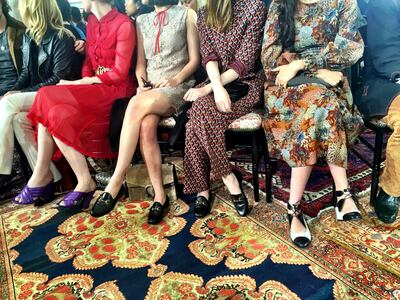
The front row at Gucci Cruise 2016 | Source: BoF
The world today is going so fast. We are in the digital age and six months today are not six months before. Gucci was in a moment where it needed to make a big, big statement. And delaying six months in order to make sure that it was more perfect? I’m not really sure that in fashion you can create something more perfect. I think most of the time, especially today, emotions should take the lead more than rationality. Otherwise we become too methodical in our choices.
The idea for the [first] two shows was: don’t think about being commercially viable. Make a statement that's going to the extreme. Then, you can fine-tune it afterwards. We cannot please everybody: I mean, in fashion today, you’re going to please someone and they’re going to love you and someone else is going to hate you. That’s fine.
Of course [there was] also pressure coming from the market that was quite important because people relied on our sales. The overall results, the figures, are a consequence of choices. Gucci lost market share in the last few years, it’s a fact. So Gucci needed a change.
Alessandro already had in mind what he wanted to do for 12 years: a different way of envisioning Gucci. So why wait?
IA: I’d like you to settle something. Is it true that Alessandro put together that first menswear show in five days?
MB: It’s absolutely true. I spoke to Frida on January 7th or the 8th and I told Alessandro to go for it. We knew that the structure of Gucci was able to create a collection in five days. I could not have done that in other companies, but at Gucci it was feasible because the structure below is so powerful. And Alessandro knew all of that — how to interact, what to ask, who to ask, etc.
IA: Take me to the night before that first men’s show, as you saw the collection coming together, what were you thinking?
MB: The night before was very interesting. It was the first show for Alessandro but he was unnaturally calm. That is his strength.
We went through the looks. Alessandro was asking me: “What do you think?” I went through and I picked all the looks that were the most extreme. I was telling him, without telling him, “Go for it! Don’t stay in the middle because if you stay in the middle, you’re going to be killed. It is better if you go for it completely and you take a stance.”
In a [fashion] business there are many tools for impact: advertising, the collection, the shows. We [only] had the shows. The advertising campaign was already out — something that was not designed by Alessandro. Collections take at least six months to be in the shops, so how can you really have an impact? The shows became more important than ever in this particular moment.
I’m a CEO, I’m not a creative person. I need to keep in mind that creative people like Alessandro know more than me. I need to respect that. Even if I don’t understand it, we cannot overlap. I need to respect their competence and they need to respect mine.
IA: You seem to have a real sensitivity for creative people. Do you think that comes from having worked with Tomas Maier and Stella McCartney?
MB: What I understood from working with them and watching them was that they have this sensitivity and this capability that is something unique that has been built over time, through their schooling, their daily lives. It’s something that I don’t have.
So, you need to give them the full spectrum of possibilities to support them. I try to understand what their strengths are, to cover their weaknesses and to enhance their strengths. For in any case, you cannot be so egocentric to try and change people, but you can get the best from them by knowing them; how they work; how they work with other people; what they fear; what they don’t like. Trying to know all of that, and trying to make sure that the company and their [teams] are tailored according to that.
Everything starts from respect. For me, that is not just with the creative director. I will never accept people harassing other people. Our business is special where every single activity is through people. If I have people who are telling people that they are not good or that if they do not perform then everything is going to be killed, they will never take risks, either in business or in fashion. With creativity, you need to feel good!
IA: Yes, as much as this is about an aesthetic and brand transformation, it is also a cultural transformation. We know from the press that the way Gucci was run before was very different from what you’re describing now. This reinvention is about getting thousands of people around the world excited and aligned behind a new vision. How are you doing that?
MB: That has been the most difficult thing to do because there are 11,000 people working at Gucci. I know my strengths and I know my weaknesses, and one of my strengths is very much about interaction and the [ability] to get the best out of people.
We needed to tell the whole organisation what was happening because from January to September there [would be] no visible impact in the shops. Most of our people are in the shops, so in order to keep a high-level motivation I needed to talk to them. I needed to tell them how we are changing the store concept, how we are changing the collections, how we are changing the organisation, and why.
So what I did was visit practically all the countries. I met with over 3,000 people, shaking hands with everybody. I presented the strategy and the vision and explained what I was expecting from them. I’m trying to let them take risks as well and understand that we were willing to accept mistakes, because if you’re innovating, of course you’re going to make mistakes.
We needed to tell the whole organisation what was happening because from January to September there would be no visible impact in the shops. I needed to tell them how we are changing the store concept, how we are changing the collections, how we are changing the organisation, and why.
I was a living example because I had [just] appointed a totally unknown creative director. I wanted to create a kind of learning organisation. That is [now] happening, and it is really empowering all my direct reports to do the same with their teams. What I’m [saying] all the time to my team is that we cannot gather 100 percent of information. It is impossible. So of course you’re going to take a risk, but it is better if you decide.
The worst that can happen in the region, for any function that is not in Milan, is [that they are] waiting for answers; they’re stuck, they don’t know — so I tell them yes, but maybe it doesn’t work. And so we need to create this kind of pace, because today especially for an organisation like Gucci that is being like a ministry with so many people, so many layers. I don’t want people to work to justify their job. They need to work because they want to achieve something.
IA: Let’s talk about the operational transformation. The first thing that comes to mind is merchandising. When you encourage your creative director to take the most extreme idea and to really push it to the max, the press might react and say “Wow” but the buyers might respond differently. At the end of the day, you need to create something that people will desire.
MB: Yes, that is the point. The way in which merchandising [at Gucci] was managed in the past was very much figures oriented. I had tonnes of data. I mean, if I asked how the handbags were doing, I had 2,000 KPIs! The strategy was very much [oriented] to the figures and less to the feeling or sensibility of the product.
So I decided to change the structure of merchandising and hired [Jacopo Venturini] from Valentino. I really wanted to work with [Venturini], because I saw that he was so into the product, the sensibility of the product.
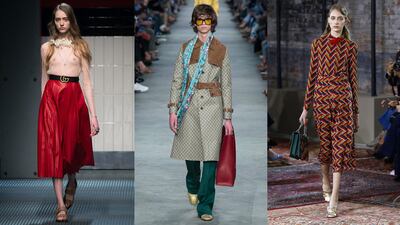
From left: Gucci Women's A/W15, Gucci Men's S/S16, Gucci Women's Cruise 2016 | Source: Indigital
What I didn’t want was for Alessandro to do the collection, and then at the end of the season say: “The bestsellers, you need to do [them] in a different colour, a different size.” It’s too late. You need to do it together with them. And together, the three of us, we need to meet like this. Because of course, if someone is [just] going to protect his vision and say: “I won’t show you what I’m doing.” that is something that cannot work any more today. Especially for a big company like ours.
So there are amazing shows, but then you go into the showroom and it is even better. I did my personal order and I kept on buying and buying and buying. And, to me, that is the best thing, because when you go there you want to buy.
There’s something happening. It is the link between business and creativity. And the more I work in this business, the more I think it is less and less number driven and more and more product driven.
IA: The one thing that is hard to change, because it can’t be changed quickly, is the stores. There’s a disconnect now between the product and the stores. How will you address that?
MB: We have already approved the new shop concept. The idea was to try to recreate the feeling that we had in the original shops of ready-to-wear. It is a cocoon that is able to give maximum expression to the collection of Alessandro.
The very first shop will be Milan. By mid-October, it will be finished. We’re going to have at least 30 shops done by the end of this year, worldwide. So, we’re moving quickly.
The most visible shops will be redone with the new concepts while others will be cleaned to reflect the same feeling, by taking out all the gold, all the dark, all the brown, all the dark mirrors to give a little bit more light to the shops.
IA: Can you talk to me about the initial results, the initial feedback that you’re getting from the market?
MB: I have two things to say. The first is that the impact of the collection and Alessandro is still tiny because I mean the number of items that we have in the shops is small. It’s a miracle that in June we had some of the items from his first collection.
We’ve completely changed the supply chain processes in the last six months. Last year we were launching Cruise at the end of October, but it was much bigger in November, and this year it is going to be in September. It is therefore going to be two months in advance and that is the reason why I expect the real impact to come in the fourth quarter.
IA: It seems the reinvention of Gucci is actually a really unique challenge after all, touching every single aspect of the organisation, and that actually all your work before has uniquely prepared you for this.
MB: That is a very good point because after a week in Gucci, I really realised it was the most interesting thing and I still [feel] like this. It is a unique brand and what I found especially was unique people. The team that I have today is [the best] in the industry. If I’m able to get another 20 percent from all of us, I mean the impact is going to be huge. And it is something that you feel. You feel the energy when you shake hands and people are smiling. Energy creates energy.
The key is to create and to empower creativity, it is the only way.
This interview has been edited and condensed.
This article appears in BoF's third annual #BoF500 special print edition, celebrating the most influential people shaping the global fashion industry. To order copies for delivery anywhere in the world or locate a stockist, visit shop.businessoffashion.com.
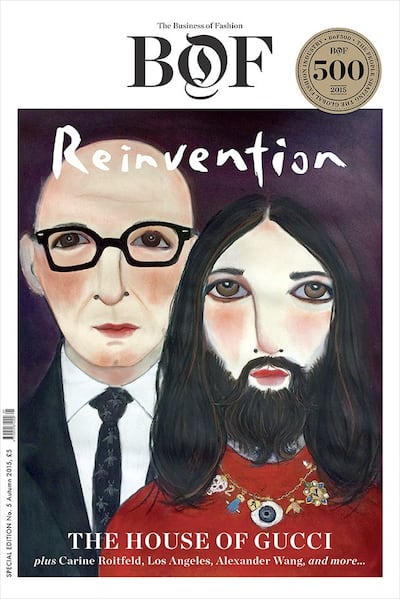
This week, more luxury brands will report first-quarter results, offering clues as to how broad and how deep the downturn is going to get.
Fashion brands are edging in on the world’s largest gathering of design professionals and their wealthy clients, but design companies still dominate the sector, which is ripe for further consolidation, reports Imran Amed.
Blocking the deal would set a new precedent for fashion M&A in the US and leave Capri Holdings in a precarious position as it attempts to turn around its Michael Kors brand.
After preserving his fashion empire’s independence for decades, the 89 year-old designer is taking a more open stance to M&A.